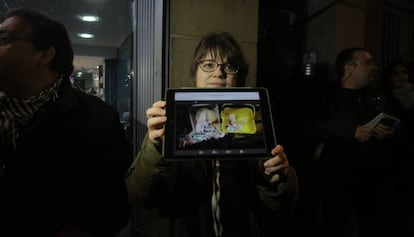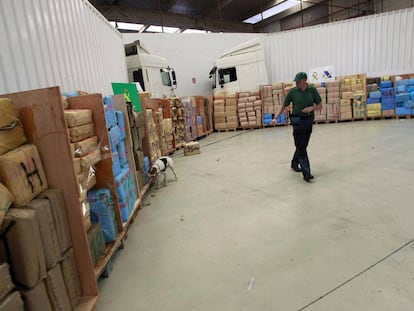Residents in Barcelona’s El Raval suffer the hell of living next to drug dens
Locals organize “narco-tour” of neighborhood‘s troubled areas, filled with gangs peddling drugs and prostitution


“Now there are 50 narco-apartments in El Raval and no one is doing anything about it. They want to drive us to desperation so we will abandon our homes. We need someone to tell us why,” says Carlos, who, like the other El Raval residents, prefers not to reveal his surname. Living just a stone’s throw from the famous La Rambla tourist thoroughfare, he has added his voice to the cry for help to anyone prepared to listen.
Life in El Raval has always been complicated, but during the last year it has become downright impossible. And, with little or nothing to lose, the residents have joined forces and delivered an ultimatum. A dozen of them also laid on a “narco-tour” around El Raval to which they invited 35 members of the media.
Life in El Raval has always been complicated, but during the last year it has become downright impossible
The route took two hours to complete and revealed at least eight locations where misery, suicide, drugs, crime and sometimes prostitution are flourishing. It is a lethal cocktail, particularly when gentrification and rising property prices are added to the mix – to push residents out, as Carlos claims.
Members of the Neighbors Association from a handful of streets, namely Isla Robadors-Picalquer-Roig, act as improvised guides to the underbelly of El Raval.
Luis, who owns an apartment in d’En Roig Street, knows how the dealers work. “They’re organized,” he says. “They have helpers walking around the neighborhood looking out for apartments that they move into in a flash.”
The residents look angry and indignant. Their expression is one of dread. They answer questions promptly, one of which is: How do you cope with living next to a narco-apartment?
They have helpers walking around the neighborhood looking out for apartments that they move into in a flash Luis, local resident
Rosi, from Sant Vicenç Street lives in front of premises that have been turned into a narco-apartment three stories high where people are constantly going in, some say at a rate of more than 100 an hour, to buy drugs. “The premises have been set on fire twice and are filled with gas canisters and bicycles,” says Vanessa who lives on the same street. “We know the modus operandi. Most of the clients don’t have money. For every stolen bicycle, they give them the equivalent of €10 – an injected speedball made of €5 worth of heroin and €5 of cocaine.”
Drugs in El Raval are sold on the street. “Before, it was just in South Raval, now it’s in the whole neighborhood,” says Eli. It is also divided by nationality. “In most of the apartments, the dealers are from Dominican Republic or Romania. And there are a lot of backpacking consumers who are Italian and then there are the Filipinos,” Vanessa says, adding that the Filipinos are more discreet. “They sell Shabu [methamphetamine],” she says. “Dozens of Filipinos come on their bikes. They make a very odd noise with their mouths but don’t say anything. Before you know it, they’re off with the goods.”
The narco-tour starts at number 22, d’En Roig Street, the building that accommodates three narco-apartments and prompted the first complaints. It is weeks since the apartments were boarded up. But on the stairway, there are still needles, dirt and blood stains on the walls. Two streets away in Robadors, Laura describes what it is like to be surrounded by this kind of set up. “They might not take drugs there and then, but girls and customers are going up and down constantly,” she says. “There are fights and sexual exploitation and I have to make my way through this with my son’s stroller.”
For every stolen bicycle, they give them the equivalent of €10 – an injected speedball made of €5 worth of heroin and €5 of cocaine Vanesa, local resident
Carlos says that in spring there will be a national meeting of neighbors who have fallen victim to this phenomenon. “The residents of El Raval will get together with residents from Puente de Vallecas and Lavapiés in Madrid and other areas of Seville and Valencia,” he says.
Meanwhile, Barcelona’s City Hall set up a commission to deal with the problem last fall. It admits that the spread of narco-apartments started in 2016, when a number of dealers moved to the area after the Catalan Mossos d’Escuadra police tackled drug trafficking in Sant Adrià del Besos. Together with local police, the regional police made 46 raids and 60 arrests in 2017. In many instances, however, the properties, which often belong to banks or vulture funds, are promptly occupied again for the same purpose.
English version by Heather Galloway.
Tu suscripción se está usando en otro dispositivo
¿Quieres añadir otro usuario a tu suscripción?
Si continúas leyendo en este dispositivo, no se podrá leer en el otro.
FlechaTu suscripción se está usando en otro dispositivo y solo puedes acceder a EL PAÍS desde un dispositivo a la vez.
Si quieres compartir tu cuenta, cambia tu suscripción a la modalidad Premium, así podrás añadir otro usuario. Cada uno accederá con su propia cuenta de email, lo que os permitirá personalizar vuestra experiencia en EL PAÍS.
¿Tienes una suscripción de empresa? Accede aquí para contratar más cuentas.
En el caso de no saber quién está usando tu cuenta, te recomendamos cambiar tu contraseña aquí.
Si decides continuar compartiendo tu cuenta, este mensaje se mostrará en tu dispositivo y en el de la otra persona que está usando tu cuenta de forma indefinida, afectando a tu experiencia de lectura. Puedes consultar aquí los términos y condiciones de la suscripción digital.
More information
Últimas noticias
Most viewed
- Pablo Escobar’s hippos: A serious environmental problem, 40 years on
- Reinhard Genzel, Nobel laureate in physics: ‘One-minute videos will never give you the truth’
- Why we lost the habit of sleeping in two segments and how that changed our sense of time
- Charles Dubouloz, mountaineering star, retires at 36 with a farewell tour inspired by Walter Bonatti
- The Florida Keys tourist paradise is besieged by immigration agents: ‘We’ve never seen anything like this’










































